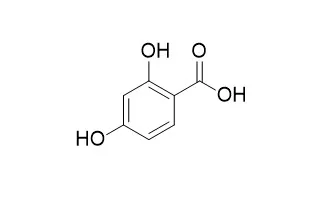| In vitro: |
| Chemical Engineering Science, 2002, 57(5):767-778. | | Anodic oxidation of 2,4-dihydroxybenzoic acid for wastewater treatment: Study of ultrasound activation[Reference: WebLink] |
METHODS AND RESULTS:
The electrooxidation at a platinum electrode of 2,4-Dihydroxybenzoic acid (2,4-DHBA) assisted by ultrasound was investigated at two frequencies (20 and ). At high frequency, hydroxyl radicals are generated, which directly oxidise organic pollutants whereas, at low frequency, mass transfer rates of the electroactive species from the bulk solution to the electrode surface as well as adsorption/desorption mechanisms are considerably accelerated. For a initial concentration and a current density, the TOC decrease was 47% after passing an electricity amount of at low frequency and only 32% after passing at high-frequency sonoelectrooxidation or electrooxidation. At low frequency, 2,4-DHBA degradation is accelerated and final TOC is lower: cavitation phenomena ensure the cleaning of the electrode surface thus increasing the active electrode surface.
CONCLUSIONS:
Observed by-products of sonoelectrodegradation are the same as for electrooxidation alone, including the following: 2,3,4- and 2,4,5-trihydroxybenzoic acids (THBA), maleic acid, glyoxylic acid and oxalic acid. Fewer intermediate aromatic compounds are formed at low-frequency irradiation. Moreover, the faradaic yield increases under low-frequency sonication, showing a more efficient use of electrochemical energy. Nevertheless, the overall energy consumption remains high . | | Journal of Chromatography A, 1986, 367(1):69-76. | | 2,4-Dihydroxybenzoic acid as a novel eluent in single column anion chromatography[Reference: WebLink] | 2,4-Dihydroxybenzoic acid has been studied as an eluent for single column ion chromatography with indirect UV detection. The advantages of this eluent are discussed.
METHODS AND RESULTS:
Only low concentrations of 2,4-Dihydroxybenzoic acid in the mobile phase are needed. Eighteen anions could be detected. The early eluting anions such as silicate and fluoride show well separated peaks and can be determined simultaneously with other common anions. The detection limit is e.g., 150 ppb for silicate (as Si) and 50 ppb for fluoride. It is shown that this method can be applied to the determination of anions in tap- and mineral-water samples. A baseline separation is obtained in about 20 min. Many other applications are possible because of the high resolution of this system, thus also silicate, phosphate and arsenate can be separated.
CONCLUSIONS:
The loss of ion-exchange capacity poses no problem since a decrease in the concentration of 2,4-Dihydroxybenzoic acid results in almost the same chromatogram as before. | | Journal of Hazardous Materials, 2012, 237-238(OCT.30):p.71-78. | | Degradation of 2,4-dihydroxibenzoic Acid by Vacuum UV Process in Aqueous Solution: Kinetic, Identification of Intermediates and Reaction Pathway。[Reference: WebLink] | 2,4-Dihydroxybenzoic acid (2,4-DHBA) is found frequently as a pollutant in natural waters and represents a threat to water quality because it is a precursor to the formation of quinones which are highly toxic.
METHODS AND RESULTS:
The degradation of 2,4-DHBA using the vacuum UV photolysis of water has been investigated. Irradiation was carried out in an annular photoreactor equipped with a Xe-excimer lamp situated in the centre and emitting at 172 nm. The degradation kinetic followed a pseudo first order and the reaction has been found to be very heterogeneous, especially at low concentration. Impacts of oxygen or temperature have also been investigated but no effect has been shown. LC-MS and HPLC-UV combined with other analytical techniques allowed the identification of the formation of trihydroxybenzoïc acids and trihydroxybenzenes which underwent a ring opening, conducting to the formation of aliphatic products named α, β, δ and γ. These products were in turn degraded successively into maleïc acid, malic and succinic acid, malonic acid, glyoxalic acid and oxalic acid before reaching the complete mineralization in about 180 min. The proposed reaction pathway has shown to be very different from the one observed for the TiO(2) photocatalysis which involves only holes (h(+)) without any formation of aromatic intermediates.
CONCLUSIONS:
The different behaviours of 2,4-DHBA towards the h(+) and HO make it a good probe to identify involved entities. |
|






 Cell. 2018 Jan 11;172(1-2):249-261.e12. doi: 10.1016/j.cell.2017.12.019.IF=36.216(2019)
Cell. 2018 Jan 11;172(1-2):249-261.e12. doi: 10.1016/j.cell.2017.12.019.IF=36.216(2019) Cell Metab. 2020 Mar 3;31(3):534-548.e5. doi: 10.1016/j.cmet.2020.01.002.IF=22.415(2019)
Cell Metab. 2020 Mar 3;31(3):534-548.e5. doi: 10.1016/j.cmet.2020.01.002.IF=22.415(2019) Mol Cell. 2017 Nov 16;68(4):673-685.e6. doi: 10.1016/j.molcel.2017.10.022.IF=14.548(2019)
Mol Cell. 2017 Nov 16;68(4):673-685.e6. doi: 10.1016/j.molcel.2017.10.022.IF=14.548(2019)